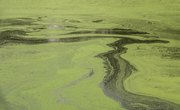
Fertilizers play an essential role in modern agricultural production, with approximately 20 million tons used annually in the United States alone. However, their use can cause imbalance within the environment, and excessive use of fertilizer can have serious consequences, especially in aquatic ecosystems.
What Does Fertilizer Do?
Fertilizers release nutrients into the soil, primarily nitrogen, phosphorus and potassium. These nutrients are essential for plant growth and are used to boost crop production. However, they can also lead to increased weed growth, which can impact crops and natural ecosystems.
How Does Fertilizer Affect the Environment?
Fertilizers are designed to be water-soluble so that they can dissolve into the soil. When more fertilizer is applied than crops or plants can take up, the excess seeps into groundwater supplies and is then discharged into lakes, rivers and oceans. Fertilizer runoff has a negative impact on aquatic systems because it can cause major disruptions and imbalance to the local ecology.
Why Are Nutrients From Fertilizer Harmful to Aquatic Ecosystems?
Fertilizer runoff has a negative impact on aquatic ecosystems because it can fuel the growth of massive harmful algal blooms. Some of these are so extensive they can be observed from space. Algal blooms are produced by rapid reproduction of microalgae, which are single-celled organisms that include cyanobacteria, dinoflagellates and diatoms.
Blooms in freshwater environments are generally green and are associated with cyanobacteria, while blooms in saltwater environments can be red or green and are usually caused by dinoflagellates and diatoms. Harmful algal blooms can have several serious consequences for humans and the environment.
Dissolved nutrients in the water can also cause direct effects on humans and other animals. High levels of dissolved nitrates (nitrogen-based compounds) can be dangerous to humans, livestock and wildlife. It can cause methemoglobinemia (blue-baby syndrome) in infants and other animals, and can cause nitrate poisoning in livestock, where it interferes with oxygen uptake in the circulatory system.
Hypoxic Water Conditions
When algal blooms die off, the decomposition process consumes a large portion of the available dissolved oxygen in the water column. This can lead to hypoxic water conditions, defined as less than two parts per million of dissolved oxygen.
These oxygen-poor conditions can lead to reduced biodiversity and cause large fish-kill events, where many thousands of fish die from suffocation. Shallow or enclosed bodies of water, such as lakes, bays and inlets are particularly susceptible to these hypoxic water conditions.
Creation of Dead Zones
In some areas, long-term hypoxic conditions have led to the creation of large areas that are mostly devoid of life. These areas are termed dead zones due to the significant reduction of marine organisms. The largest known dead zone is in the Gulf of Mexico, where the Mississippi River discharges into the sea.
Draining a large portion of the United States, including much of the most productive farmland, the Mississippi River is heavily charged with nutrients from fertilizer, and the warm, shallow waters reduce nutrient dispersal and create ideal conditions for algal growth.
The size of the Gulf of Mexico dead zone fluctuates and is influenced by weather, nutrient application rates and climatic conditions. Other dead zones have been recorded in the Chesapeake Bay in Virginia, the Baltic Sea in northern Europe and the Black Sea in Turkey.
Algal Toxicity
Algal blooms can be toxic to humans, domestic animals and wildlife. The most common toxic bloom in the United States is caused by Karina brevis, which cause red blooms often referred to as "red tides." These algae produce a type of toxin called brevetoxins.
People can be affected by swimming or doing other water activities, by breathing in sea spray, or by eating contaminated fish or shellfish. Serious illnesses caused by brevetoxins include ciguatera fish poisoning, neurotoxic shellfish poisoning and paralytic shellfish poisoning. These toxins can affect many marine species like dolphins, sea lions and seabirds, leading to illness and death in these animals.
Other Effects of Algal Blooms
Other effects of algal blooms include contamination of freshwater, which can affect drinking water supplies and industries that rely on uncontaminated water. Treating contaminated water can be difficult and costly. Algal blooms can also emit offensive and sometimes toxic fumes and reduce the visual amenity of popular recreation areas. When this occurs recreation areas are often closed for public health and safety reasons. Complicated and expensive cleanup efforts to remediate the affected areas can be required.
References
- United States Geological Survey: The Effects of Agricultural Fertilizer Runoff Upon Aquatic Ecosystems
- Microbial Life Educational Resources: The Gulf of Mexico Dead Zone
- Statista: Total U.S. Fertilizer Use From 2010 to 2025
- Center for Disease Control and Prevention: Harmful Algal Bloom (HAB)-Associated Illness
- Environmental Protection Agency: Harmful Algal Blooms
- North Dakota State University: Environmental Implications of Excess Fertilizer and Manure on Water Quality
About the Author
Born and raised in Western Australia, I have been fascinated by the natural world for as long as I can remember. I studied Conservation Biology at Murdoch University before working as a government field researcher, project leader for community-led bushland regeneration programs, private botanical consultant and environmental educator. Although fascinated by all things ecological, a particular interest is regenerative agriculture and its potential to help transform our entire relationship with the natural world in which we depend.
Photo Credits
mountain and lake scene,buttermere in the lake d image by adrian fortune from Fotolia.com
